Setting up Water Level and Water Flow Channels
You can set up water level and water flow channels for RX2103 and RX2104 stations with an installed water level sensor or for RX3000 stations with a water level sensor module (RXMOD-W1). Water level and water flow are calculated at each logging interval based on the measurements from the pressure and temperature channel and the settings and values that you enter in the configuration screens. Note: If a water level sensor is not physically connected to the station, barometric pressure will be the only channel logged and you will not be able to set up water level and water flow channels.
If you need to set up the logging interval for the water level sensor module or add labels, enable graphs, or set up scaling for pressure and temperature channels, see Module/Sensor Configuration.
Important: Make sure the station has started logging and you have then taken a reference water level reading with the date and time of the reading before performing these steps.
To set up a water level channel:
- Click Devices and then RX Devices, and find the station you want to configure. Click the arrow next to the
 icon and select Module/Sensor Configuration.
icon and select Module/Sensor Configuration. - Under Module 1 (or 2): Water Level Sensors Logging on the left menu, select Water Level.
- Click the checkbox to Enable Channel.
- Click the checkbox to Enable Graph and type a label (optional).
- Enter the reference water level and date and time the reading was taken.
- If the water level surface is below the reference point, enter the reference water level as a negative number.
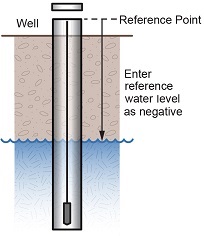
- If the water level surface is above the reference point, enter the reference water level as a positive number.
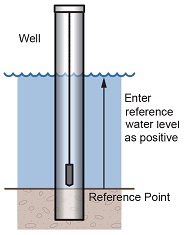
- Select the appropriate water density for your deployment location. If selecting static density, enter the value in kg/m3 or lb/ft3.
- Click Save (or click Next to move to the next configuration page).
Water level will be calculated starting with the next connection to HOBOlink. Note that the reference water level information entered in this step will not affect any previously logged water level data. It will only be used for data logged from the point of the next connection to HOBOlink forward.
If you are using a v-notch weir similar to the top diagram below along with the water level sensor, then HOBOlink can calculate the flow rate for each water level reading using the following two values that you enter:
- The notch (vertex) angle in degrees or radians, which is represented as θ in the bottom diagram below.
- The distance from the reference point to the v-notch vertex, which is represented as WLv in the bottom diagram below. This value must be entered in the same units as the reference water level you entered for the water level channel (meters or feet).
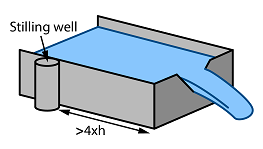
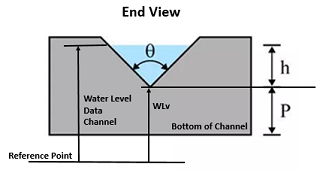
The HOBOlink water flow calculations for a v-notch weir assume the following:
- The stilling well with the water level sensor should be placed at a distance of at least 4 x hmax upstream of the weir.
-
In general, if the notch area is small relative to the area of the approach channel, the weir is “fully contracted” and these flow equations will work. More specifically, the ratio of the channel width to the v-notch width should be greater than 3, and the ratio of hmax/p should be less than 1. It may also work for weirs not meeting these guidelines if the approach channel is smooth, straight, and rectangular.
- The weir should be between 0.8 and 2 mm (0.03 and 0.08 inches) thick in the v-notch. If the bulk of the weir is thicker than 2 mm (0.08 inches) the downstream edge of the v-notch can be chamfered at an angle greater than 45° (60° is recommended) to achieve the desired thickness of the edges. Avoid water clinging to the downstream face of the weir.
- The head height (h) must be no more than 35% of the distance from the channel bottom to v-notch-vertex (P).
- The head height must be at least 0.06 m (0.2 ft). When the head height is less than 0.06 m (0.2 ft), the flow calculation will not be as accurate.
- The average width of the approach channel should be greater than 0.91 m (3 ft).
- The bottom of the v-notch should be at least 0.45 m (1.5 ft) above the bottom of the upstream channel.
Important: Make sure the station has started logging and you have configured the water level channel with a reference level reading before completing these steps.
Configuring a Flow Channel for a V-Notch Weir
To set up a water flow channel using a v-notch weir:
- Click Devices and then RX Devices, and find the station you want to configure. Click the arrow next to the
 icon and select Module/Sensor Configuration.
icon and select Module/Sensor Configuration. - Under Module 1 (or 2): Water Level Sensors Logging on the left menu, select Water Flow.
- Click the checkbox to Enable Channel.
- Click the checkbox to Enable Graph and type a label (optional).
- For the Measurement Method, select V-Notch Weir.
-
Enter the notch (vertex) angle of the weir in degrees or radians.
-
For the “Water level at vertex,” enter the distance from the reference point to the v-notch vertex in either meters or feet (using the same reference point and units you used for the reference water level in the water level channel).
- If the vertex is the reference point, then enter 0.
- If the reference point is the bottom of the channel, then the value is represented as P in the diagram earlier in this section.
- If the reference point is above the water level (such as when using ground level as the reference point in a storm sewer), then enter a negative number.
- If the reference point is below the water level, then enter a positive number.
- Water flow will be calculated starting with the next connection to HOBOlink.
- Click Save (or click Next to move to the next configuration page).
Tip: It is good practice to set an alarm for the water level just below at the top of the v-notch so you know when the flow data is close to exceeding its valid range. See Sensor Alarms in Chapter 2 for details on setting up an alarm in HOBOlink.
If you are using a rectangular thin-plate weir similar to the diagram below on the left along with the water level sensor, then HOBOlink can calculate the flow rate for each water level reading using four values that you enter. Note that these values must be entered in the same units as the reference water level you entered for the water level channel (meters or feet). The values are:
- The notch width, which is represented as b in the bottom diagram below.
- The channel width, which is represented as B in the bottom diagram below.
- The notch height above the channel floor, which is represented as P in the bottom diagram below.
- The distance from the water level reference point to the notch crest, which is represented as WLc in the bottom diagram below.
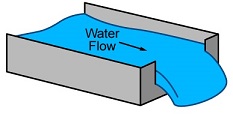
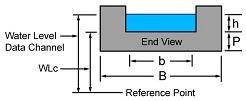
The HOBOlink water flow calculations for a rectangular weir assume the following:
- The range for the weir opening width is 0.15 to 6 m (0.5 to 20 ft).
- The notch height (P) must be at least 0.1 m (0.33 ft).
- Either B = b (full-width weir) or B - b must be at least 0.2 m (0.66 ft) (contracted weir).
- The weir should be between 1 to 2 mm (0.03 to 0.08 inches) thick in the opening. If the bulk of the weir is thicker than 2 mm (0.08 inches), the downstream edge of the opening can be chamfered at an angle greater than 45° (60° is recommended) to achieve the desired thickness of the edges, and avoid water clinging to the downstream face of the weir.
- The range for the head height (h) is 0.03 to 1.4 m (0.18 to 4.5 ft).
- The range for the flow rate is from 3.45 to 17,188 l/s (0.122 to 607 ft3/s).
- The value of h/p cannot be greater than 2.5.
- Water surface downstream of the weir should be at least 0.06 cm (2.36 inches) below the weir crest (i.e. below the bottom of the opening).
Configuring a Flow Channel for a Rectangular Weir
Important: Make sure the station has started logging and you have configured the water level channel with a reference level reading before completing these steps.
To set up a water flow channel using a rectangular weir:
- Click Devices and then RX Devices, and find the station you want to configure. Click the arrow next to the icon and select Module/Sensor Configuration.
- Under Module 1 (or 2): Water Level Sensors Logging on the left menu, select Water Flow.
- Click the checkbox to Enable Channel.
- Click the checkbox to Enable Graph and type a label (optional).
- For the Measurement Method, select Rectangular Weir.
- Enter the notch width in either meters or feet. Note: Use the same units for this and all rectangular weir values as you entered for the reference water level in the water level channel.
- Enter the channel width in either meters or feet.
- Enter the notch height above the channel floor in either meters or feet.
- For the Distance from Water Level Ref Point to Notch, enter the distance from the reference point to the notch crest in either meters or feet.
- If the notch crest is the reference point, then enter 0.
- If the reference point is the bottom of the channel, then the value is represented as P in the diagram earlier in this section.
- If the reference point is above the water level (such as when using ground level as the reference point in a storm sewer), then enter a negative number.
- If the reference point is below the water level, then enter a positive number.
10. Click Save (or click Next to move to the next configuration page).
Water flow will be calculated starting with the next connection to HOBOlink.
If you are using a trapezoidal or Cipoletti thin-plate weir similar to the diagram below on the left along with the water level sensor, then HOBOlink can calculate the flow rate for each water level reading using two values that you enter. Note that these values must be entered in the same units as the reference water level you entered for the water level channel (meters or feet). The values are:
- The width at the base of the notch, which is represented as b in the bottom diagram below.
- The distance from the water level reference point to the notch crest, which is represented as WLc in the bottom diagram below.
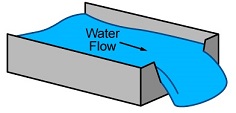
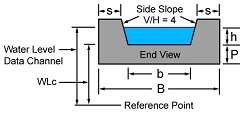
The HOBOlink water flow calculations for a trapezoidal weir assume the following:
- The slopes of the notch sides must be 4 (vertical change / horizontal change).
- Head height (h) should be measured at a distance of at least 4 x hmax upstream of the weir.
- The weir should be between 1 to 2 mm (0.04 to 0.08 inches) thick in the opening. If the bulk of the weird is thicker than 2 mm (0.08 inches), the downstream edge of the opening can be chamfered at an angle greater than 45° (60° is recommended) to achieve the desired thickness of the edges and avoid water clinging to the downstream face of the weir.
- Water surface downstream of the weir should be at least 0.06 m (0.2 ft) below the weir crest (i.e. below the bottom of the opening).
- The head height (h) must be at least 0.06 m (0.2 ft), but less than b/3.
- The crest height above the channel floor (P) is measured from the bottom of the upstream channel and should be greater than 2 x hmax.
- “S” is measured from the sides of the channel and should be greater than 2 x hmax.
Configuring a Flow Channel for a Trapezoidal Weir
Important: Make sure the station has started logging and you have configured the water level channel with a reference level reading before completing these steps.
To set up a water flow channel using a trapezoidal weir:
- Click Devices and then RX Devices, and find the station you want to configure. Click the arrow next to the icon and select Module/Sensor Configuration.
- Under Module 1 (or 2): Water Level Sensors Logging on the left menu, select Water Flow.
- Click the checkbox to Enable Channel.
- Click the checkbox to Enable Graph and type a label (optional).
- For the Measurement Method, select Trapezoidal Weir.
- Enter the notch width at the bottom in either meters or feet, using the same units as you entered for the reference water level in the water level channel.
- For the Distance from Water Level Ref Point to Notch, enter the distance from the reference point to the notch crest in either meters or feet (using the same reference point and units you used for the reference water level).
- If the notch crest is the reference point, then enter 0.
- If the reference point is the bottom of the channel, then the value is represented as P in the diagram earlier in this section.
- If the reference point is above the water level (such as when using ground level as the reference point in a storm sewer), then enter a negative number.
- If the reference point is below the water level, then enter a positive number.
8. Click Save (or click Next to move to the next configuration page).
Water flow will be calculated starting with the next connection to HOBOlink.
If you are using a flume along with the water level sensor, then HOBOlink can calculate the water flow using a general flow equation supported by a wide range of flumes that require only one water level measurement to calculate flow, including ramp, cutthroat, Parshall as well as broad-crested rectangular weirs. The equation that HOBOlink uses is: Water Flow (Q) = C * (Water Level - Head Offset)n. Flumes that require two or three water level measurements to calculate flow are not supported.
For this equation to be accurate, there are constraints on the flow conditions and flume design, including:
- Minimum and maximum flow rates
- Minimum and maximum head levels
- Ratio of the width of the weir/flume to the head
- Ratio of the height of the weir/flume to the head
- Location in the flume or weir for measuring the head.
The constraints depend on the type and characteristics of the flume you are using, which can be obtained from the flume manufacturer.
Configuring a Flow Channel for a General Flume
Important: Make sure the station has started logging and you have configured the water level channel with a reference level reading before completing these steps.
To set up a water flow channel using a general flume:
- Click Devices and then RX Devices, and find the station you want to configure. Click the arrow next to the
 icon and select Module/Sensor Configuration.
icon and select Module/Sensor Configuration. - Under Module 1 (or 2): Water Level Sensors Logging on the left menu, select Water Flow.
- Click the checkbox to Enable Channel.
- Click the checkbox to Enable Graph and type a label (optional).
- For the Measurement Method, select General Flume.
- For the Flume Coefficient, enter the C value listed in your flume’s equation table, which can typically be found in the flume manufacturer’s documentation. The Flume Coefficient may also be labeled K by some manufacturers so be sure to check how the coefficient is being used in their equation to make sure it is the right one to enter here.
- For the Head Offset, enter the value in either meters or feet, using the same units as you entered the reference water level in the water level channel. An example of Head Offset is shown in the following diagram of a ramp flume.
- If you are using a ramp flume as shown in the diagram below and the top of the ramp is the reference point, then enter 0.
- If you are using a ramp flume and the bottom of the channel leading to the ramp (or crest) is the reference point, then enter the height of the ramp or crest for the head offset (represented as P in the diagram).

For other types of flumes, such as this example diagram where the water level (or H) is being measured from the bottom of the flume:
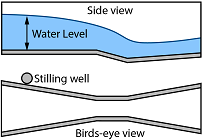
- If the bottom of the flume is the reference point for both the water level and head, then enter 0 for the Head Offset.
- If the reference point is above the water level (such as when using ground level as the reference point in a storm sewer), then enter a negative number.
- If the reference point is below the water level, then enter a positive number.
- For the Head Exponent, enter the n value listed in your flume’s equation table, which can typically by found in the flume manufacturer’s documentation.
- Click Save (or click Next to move to the next configuration page).
Water flow will be calculated starting with the next connection to HOBOlink.
You can set up a water flow channel that is calculated based on up to 20 stage-discharge points that you enter. Keep in mind that the units of the stage-discharge table for water flow are assumed to be the same as those entered for the reference water level. If the reference water level was entered in meters, then points in the table must be entered in meters and l/s (liters per second). If the reference water level was entered in feet, then points in the table must be entered in feet and cfs (cubic feet per second).
Before you begin setting up the channel, you will need to determine the values to enter into the stage-discharge table. HOBOlink does not derive a stage discharge curve. Use another method to determine the stage-discharge curve for your site and then enter points from that curve into the HOBOlink stage-discharge table. HOBOlink linearly interpolates between the points that you enter. You can estimate and enter intermediate points as needed to match your stage-discharge curve as best as possible. HOBOlink does not extrapolate beyond the lowest and highest stage values that you enter so make sure to enter values that span the full range of potential stage levels for your site, including flood conditions. Any measured water levels that are outside of the range you enter will be shown as sensor errors (-888.88) for the water flow channel.
Guidelines for Getting a Stage-Discharge Rating Curve for your Site
- If you are working with a USGS gaging site, you can use the USGS WaterWatch Customized Rating Curve Builder to get the rating curve for that site at https://waterwatch.usgs.gov/?id=mkrc.
- If there is not an existing stage-discharge rating curve for your site, then you will need to build one. This requires measuring stage and discharge at multiple stage levels over time and then creating a stage-discharge curve. A good reference on measuring stage and discharge is at https://www.usgs.gov/special-topic/water-science-school/science/how-streamflow-measured?qt-science_center_objects=0#qt-science_center_objects. More detailed information can also be found at https://pubs.usgs.gov/tm/tm3-a8/pdf/tm3-a8.pdf.
Once you have enough stage and discharge measurements for your site, you can use those measurements to create the stage-discharge curve for the site. There are two common ways to do this:
- Use a commercially available rating curve software tool, such as AQUARIUS or DataWise.
- Create your own stage-discharge curve fit for your stage-discharge measurements with a spreadsheet, such as Excel, or with a statistical program, such as R. The most common equation used for stage-discharge curves is Manning’s Equation.
- Once you have selected the type of equation to use, try different coefficients in the equation to determine which ones provide the best fit for your stage-discharge measurements.
- Use the selected equation to determine a set of values to enter in the HOBOlink stage-discharge table. If there are any levels at which there is a significant change in the stream profile, you will need to account for those as well. For example, when a stream overflows its banks, the stage-discharge relationship will change dramatically. The curve fit equation will no longer be valid so you will need a different curve-fit equation for stage levels in this range.
Configuring a Flow Channel for a Stage-Discharge Table
Important: Make sure the station has started logging and you have configured the water level channel with a reference water level reading before completing these steps.
To set up a water flow channel using a stage discharge table:
- Click Devices and then RX Devices, and find the station you want to configure. Click the arrow next to the
 icon and select Module/Sensor Configuration.
icon and select Module/Sensor Configuration. - Under Module 1 (or 2): Water Level Sensors Logging on the left menu, select Water Flow.
- Click the checkbox to Enable Channel.
- Click the checkbox to Enable Graph and type a label (optional).
- For the Measurement Method, select Stage Discharge Table.
- Enter each pair of stage-discharge points. Click Add A Row to add up to 20 pairs of points.
- If you entered the reference water level in meters when setting up the water level channel, then the points in the table must be entered in meters and l/s.
- If you entered the reference water level in feet when setting up the water level channel, then the points in the table must be entered in feet and cfs.
- Click Save (or click Next to move to the next configuration page).
Water flow will be calculated starting with the next connection to HOBOlink. Note: If you set up water flow sensor alarms, be sure the alarm limits are within the range of the stage-discharge values that you have entered.